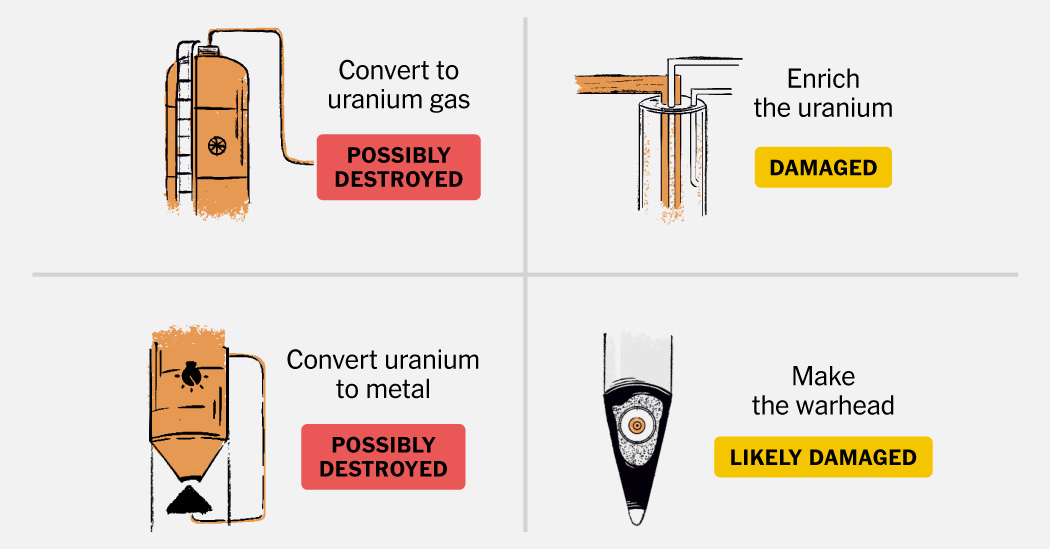Table of Contents
Sustain nuclear expertise
Likely harmed
Before strikes
Over the decades, Iran built up scientific and engineering expertise in nuclear technology.
After
Israel says it killed at least 14 of Iran’s leading nuclear experts in the recent attacks. But there is another tier of scientists in Iran who share much of that knowledge. If past experience from previous assassinations of nuclear talent holds, over time, they will likely be able to carry on the work.
Sustain nuclear expertise
Likely harmed
Before strikes
Over the decades, Iran built up scientific and engineering expertise in nuclear technology.
After
Israel says it killed at least 14 of Iran’s leading nuclear experts in the recent attacks. But there is another tier of scientists in Iran who share much of that knowledge. If past experience from previous assassinations of nuclear talent holds, over time, they will likely be able to carry on the work.
Mine uranium ore
Appears unaffected
Before strikes
Iran has two active uranium mines, both in central Iran. Iran has not reported how much it has mined in recent years, but the material, it says, is contained in one of the mines, Narigan, would be enough for more than 50 weapons.
After
Iran’s uranium mines have not been targeted by strikes during the fighting.
Mine uranium ore
Appears unaffected
Before strikes
Iran has two active uranium mines, both in central Iran. Iran has not reported how much it has mined in recent years, but the material, it says, is contained in one of the mines, Narigan, would be enough for more than 50 weapons.
After
Iran’s uranium mines have not been targeted by strikes during the fighting.
Convert uranium to gas
Possibly destroyed
Before strikes
The only known facility in Iran that could convert natural uranium into gas, in the form of uranium hexafluoride, was in Isfahan.
After
American missiles severely damaged Iran’s main uranium conversion site, most likely destroying Iran’s ability to convert natural uranium into the form required to start the enrichment process. Rebuilding could take years.
Convert uranium to gas
Possibly destroyed
Before strikes
The only known facility in Iran that could convert natural uranium into gas, in the form of uranium hexafluoride, was in Isfahan.
After
American missiles severely damaged Iran’s main uranium conversion site, most likely destroying Iran’s ability to convert natural uranium into the form required to start the enrichment process. Rebuilding could take years.
Enrich uranium
Damaged but extent unclear
Before strikes
This is the hardest part of making a nuclear bomb. Producing bomb-grade uranium requires vast arrays of high-speed centrifuges to spin the uranium gas and concentrate the enriched form. Iran’s Natanz and Fordo sites held more than 18,000 centrifuges, mostly underground.
After
Israel most likely destroyed all the centrifuges at Natanz. And the head of the International Atomic Energy Agency said the centrifuges at Fordo, Iran’s other major enrichment site built deep inside a mountain, appeared “no longer operational” after the U.S. attack. Trump said the facility was “obliterated,” though other assessments were more cautious. Israel also destroyed plants that manufactured centrifuges.
Iran has claimed it has other, secret enrichment facilities. But there is no evidence that other operational enrichment sites exist. Iran has also been assembling advanced, next-generation centrifuges at dispersed locations and, unless diplomacy or military action intervenes, may install them at two underground facilities it has been building.
Enrich uranium
Damaged but extent unclear
Before strikes
This is the hardest part of making a nuclear bomb. Producing bomb-grade uranium requires vast arrays of high-speed centrifuges to spin the uranium gas and concentrate the enriched form. Iran’s Natanz and Fordo sites held more than 18,000 centrifuges, mostly underground.
After
Israel most likely destroyed all the centrifuges at Natanz. And the head of the International Atomic Energy Agency said the centrifuges at Fordo, Iran’s other major enrichment site built deep inside a mountain, appeared “no longer operational” after the U.S. attack. Trump said the facility was “obliterated,” though other assessments were more cautious. Israel also destroyed plants that manufactured centrifuges.
Iran has claimed it has other, secret enrichment facilities. But there is no evidence that other operational enrichment sites exist. Iran has also been assembling advanced, next-generation centrifuges at dispersed locations and, unless diplomacy or military action intervenes, may install them at two underground facilities it has been building.
Store the enriched uranium
Probably still exists
Before strikes
International inspectors estimated this year that Iran had just shy of 900 pounds of nearly bomb-grade uranium. Inspectors last saw some of the stockpile about a week before Israel began its strikes. At that time, it was stored deep inside a nuclear complex near Isfahan in special casks small enough to fit in the trunks of about 10 cars.
Once further enriched, this stockpile would be enough to make nine or 10 atomic weapons, but U.S. intelligence agencies assessed that Iran had not decided whether to make a bomb.
After
A classified U.S. report said that much of Iran’s stockpile of enriched uranium was moved before the strikes. The White House has insisted that it was destroyed but cited no evidence. The I.A.E.A. and European intelligence agencies believe Iran likely dispersed its stockpiles of enriched uranium around the country.
The uranium of greatest concern has already been enriched to a purity of 60 percent, greatly shortening the time required to bring it to 90 percent, which is usually considered weapons-grade fuel. But to do so would require some hidden, working centrifuges.
Store the enriched uranium
Probably still exists
Before strikes
International inspectors estimated this year that Iran had just shy of 900 pounds of nearly bomb-grade uranium. Inspectors last saw some of the stockpile about a week before Israel began its strikes. At that time, it was stored deep inside a nuclear complex near Isfahan in special casks small enough to fit in the trunks of about 10 cars.
Once further enriched, this stockpile would be enough to make nine or 10 atomic weapons, but U.S. intelligence agencies assessed that Iran had not decided whether to make a bomb.
After
A classified U.S. report said that much of Iran’s stockpile of enriched uranium was moved before the strikes. The White House has insisted that it was destroyed but cited no evidence. The I.A.E.A. and European intelligence agencies believe Iran likely dispersed its stockpiles of enriched uranium around the country.
The uranium of greatest concern has already been enriched to a purity of 60 percent, greatly shortening the time required to bring it to 90 percent, which is usually considered weapons-grade fuel. But to do so would require some hidden, working centrifuges.
Convert enriched uranium to metal
Possibly destroyed
Before strikes
Iran had one known facility to convert enriched uranium back into its solid metal state — a critical step before it can be used in a weapon.
After
Israel destroyed Iran’s uranium metal production facility at Isfahan. Without this important capability, Iran cannot make an atomic bomb. However, one expert cautioned that Iran has produced uranium metal at other locations before, and it may have a secret site to conduct the work elsewhere.
Convert enriched uranium to metal
Possibly destroyed
Before strikes
Iran had one known facility to convert enriched uranium back into its solid metal state — a critical step before it can be used in a weapon.
After
Israel destroyed Iran’s uranium metal production facility at Isfahan. Without this important capability, Iran cannot make an atomic bomb. However, one expert cautioned that Iran has produced uranium metal at other locations before, and it may have a secret site to conduct the work elsewhere.
Make a bomb
Likely damaged
Before strikes
To build a modern atomic weapon with the metal, Iran would need to miniaturize crucial components, such as the detonator system, to fit into a missile-capable warhead. It is unclear whether Iran has this capability, but experts believe it has made some progress, and it is thought to have experimented with triggering devices. American intelligence agencies concluded last year that Iran was working on a “faster, cruder” approach to a weapon.
After
Israel destroyed several buildings at the Sanjarian manufacturing facility that were associated with the development of detonation systems and explosives, but Iran may have other similar facilities.
Make a bomb
Likely damaged
Before strikes
To build a modern atomic weapon with the metal, Iran would need to miniaturize crucial components, such as the detonator system, to fit into a missile-capable warhead. It is unclear whether Iran has this capability, but experts believe it has made some progress, and it is thought to have experimented with triggering devices. American intelligence agencies concluded last year that Iran was working on a “faster, cruder” approach to a weapon.
After
Israel destroyed several buildings at the Sanjarian manufacturing facility that were associated with the development of detonation systems and explosives, but Iran may have other similar facilities.
Deliver a weapon
Still possible
Before strikes
With a weapon, Iran could conduct a nuclear test, as North Korea first did in 2006. There are many ways to deliver a weapon, but if it wants to strike a target from afar, it needs planes or missiles to deliver it. Until recently it had thousands of missiles, many of which could carry an atomic weapon.
After
Israel claims to have destroyed hundreds of Iran’s missile launchers, but is unlikely to have completely wiped out Iran’s ability to fire a nuclear-capable missile.
Deliver a weapon
Still possible
Before strikes
With a weapon, Iran could conduct a nuclear test, as North Korea first did in 2006. There are many ways to deliver a weapon, but if it wants to strike a target from afar, it needs planes or missiles to deliver it. Until recently it had thousands of missiles, many of which could carry an atomic weapon.
After
Israel claims to have destroyed hundreds of Iran’s missile launchers, but is unlikely to have completely wiped out Iran’s ability to fire a nuclear-capable missile.


